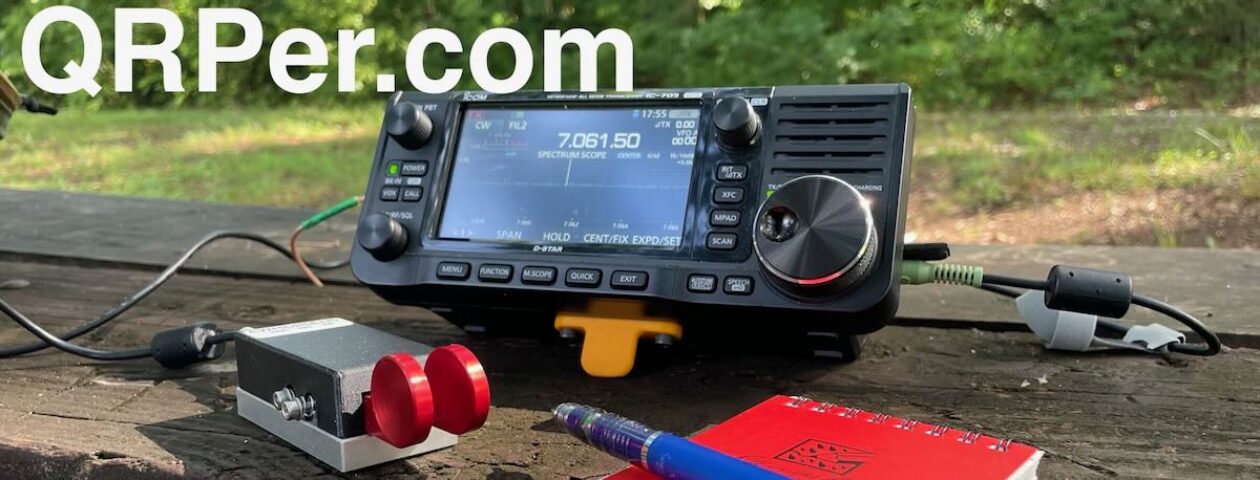by Teri (KO4WFP)
Monday, July 15, after my “botched” SOTA activation of Black Balsam, the POTA Babe headed to Richland Balsam. Richland Balsam proved to be a nice hike and activation. The mountain is further up the parkway and the highest point on it. You access the trail to the summit via an overlook just southeast of the mountain.

When I researched what summits to choose, one nice feature about this one is a bench at its top. Yes, the park service provides you a seat for your activation! Given the gain in elevation to reach that bench, you are grateful for it by the time you reach the summit!


By this point in the day, the sun had burned off the clouds and both Daisy and I appreciate sitting beneath the tree canopy shaded from the heat. While I set up my KX2 and AX1 (it has performed well enough at Black Balsam Knob, I figured it would do well here, too.), Daisy sprawled out on the forest floor at my feet.

I was a little nervous at going through all this effort with an ongoing solar flare. However, you never know what the bands are going to give unless you try.

As per Gary’s recommendation in the last article, I began with 40 meters and, in addition to working Gary, worked three other ops in short order. After ten minutes with no further callers, I moved to 20 meters. I still needed six more QSOs for a valid POTA activation at this site. They gradually trickled in over the course of an hour and a half. I had internet access at this location, too, and was able to hunt Douglas AA0AW at US-11150 in Minnesota. At this point I called QRT and reflected on the day.

The thought of not having a valid SOTA activation in the morning REALLY bothered me. It was fairly late in the day now. Would there be time to go back (yes, go back) and make a second attempt? By now those lovely cloudy skies were long gone so our second hike would be a much warmer one. If you haven’t already figured out by now, POTA Babes are tenacious and don’t give up easily. Besides, I felt the need to redeem myself.
We arrived back at the Black Balsam Knob parking area with plenty of parking now. In fact, there were only a handful of cars left. As we walked toward the trailhead, a pair of men were leaving the trail for their car. I asked them how far of a hike it is to Black Balsam Knob to which they responded about 30 minutes. Well, it was about 30 minutes I hiked that morning. Hmmm.

When we reached the same area I had that morning, I asked two different parties where the Black Balsam Knob summit was. They both responded right where I was standing! (It had taken a little over 30 minutes, partially to give Daisy a rest due to the temperature.) But where was the plaque? One gentleman confirmed there was indeed a plaque at this site and yes, this was the summit.

Well, how do you like that?! I DID have a valid SOTA activation here after all. Whew! What a relief (though I could have done without that hike a second time). I figured since we were already up here, why not try to finish the POTA activation now?
First things first, though, was to find Daisy some shade and the only way to do that was to set up the new Mountain Laurel Designs tarp I purchased for the trip. I couldn’t get the height I saw Patrick WW4D have on his tarp but it was a start. I gave Daisy the shade and sat in front of it shielding my KX2 from the sun.


I went back to 20 meters and thanks to three hunters – Keith K7MOA, Gerald N5KT, and Ken K5ENS – I had my valid POTA activation! Woo-hoo! What a day!
At this point, I heard thunder and saw lightning from a raincloud I’d been watching. It was time to get the you-know-what out of Dodge! I hurriedly threw everything into my pack and Daisy and I huffed it down the summit.

As I reflected on how the day played out, I was pleased with what I accomplished.
A successful SOTA activation is a big deal to me, to a great extent because I’ve had no one to Elmer me. There are those who’ve answered my questions and there are Youtube videos that were helpful. But the endeavor still seemed overwhelming at times, especially since I often set the bar high for myself. There are still additional skills I need for further pursuit of SOTA, especially if hiking to a summit that isn’t as easy to find as the two today were. But today was a good start. For those of you considering your first SOTA activation, if I can do it, so can you! So do your research, gather your skills, and get out there.

The track record for the trip is going well – four POTA and two SOTA activations and it is only day two! Will I keep up the pace and where will I head next? Stay tuned…
Equipment Used
[Note: All Amazon, CW Morse, ABR, Chelegance, eBay, and Radioddity links are affiliate links that support QRPer.com at no cost to you.]
























































































































